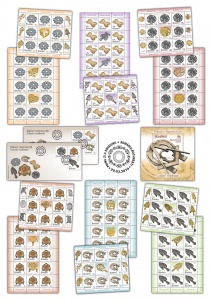Romfilatelia continues the series of Romanian Collections postage stamp issues, this time with topic Plateaus / Trivets (II). The issue consists of six stamps and an imperforated souvenir sheet, on which trivets, a generic name designating the stands with more than three legs, as well as those with one leg and one base, from the 19th-20th centuries are represented. These exhibits belonging to a prestigious collection from Bucharest, the greatest in the world, certified by Guiness World Records, in 2016.
On the stamp with the face value of Lei 1.40, is represented a Saint Valentine plateau.
The musical symbols support is illustrated on the stamp with the face value of Lei 1.60.
On the stamp with the face value of Lei 1.70 is depicted the plateau with grapes.
The stamp with the face value of Lei 7 illustrates the tall plateau.
The stamp with the face value of Lei 8.50 reproduces the image of an artistic support.
The horseshoe support is represented on the stamp with the face value of Lei 12.00 and on the stamp of the imperforated souvenir sheet of the issue, with the face value of Lei 19.00.
Trivets are objects whose artistic potential has truly been discovered only after World War I. During a time when Art Deco was still on its peak, and art became more and more a part of everyday life, the interesting designs of trivets and the craftmanship of the manufacturers began to captivate people, and trivets began to be used for their decorative role too, not just for the protection they ensured.
Thus, trivets began having two uses: protecting the surfaces against burns caused by, most often, the heat of the pressing iron, as well as other heated objects, and being a pleasant item to look at, thus having an esthetical role too.
The walls of kitchens and houses began being decorated with these objects that were skillfully made by craftsmen. The diversity of models is astonishing. Many of the trivets have a cut-in design in order to make shapes of plants, flowers, objects, animals, human silhouettes, and even texts.
The utility of trivets in protecting the surfaces began to decline at some point, but trivets survived thanks to the diversity of models and the ingenuity of the trivet makers who understood that an object doesn’t necessarily have to be just a simple tool, but that it can be, at the same time, an artistic object.
The Saint Valentine plateau dates back from the 19th century. The trivet is formed of six hearts all of which also contain six smaller hearts. By uniting them, the center of the trivet became a six-pointed star with a circle inside. The six big hearts also contain stylized cut-in models made for creating an artistic object, but also for practical reasons, in order to take as less heat as possible from the object placed on top of the trivet.
The musical symbols support is a trivet from the 19th century. This is a brass piece with four short legs, illustrating a lyre. Its model consists in cut-ins which ensure a nice shape, but also less material to take the heat from the hot object.
The plateau with grapes, trivet from the 20th century, is a decorative piece with no legs, having a round shape and illustrating grapes, the vine and its leaves. The piece is made of cast iron.
The tall plateau, trivet form the 19th century, with floral motifs, whose plateau illustrates leaves and stylized models, is a brass stand with three tall legs. As for the surface which comes in contact with the heated object, it is made of copper. A good protection of the furniture is ensured by the height of the piece and the selection of materials.
The artistic support, another piece from the 20th century, is a cast iron trivet with Art Nouveau motifs. The cut-in model of the trivet creates the whiplash curves which are specific for this artistic movement, and so is the subject which is illustrated: plants. The trivet is specially made to be used with pressing irons. Its shape is triangular so that it will fit the shape of the iron, while the edges are slightly raised in order to prevent a misplacement of the heated iron on the trivet.
The horseshoe support, a piece from the 19th century, is a brass trivet with no legs, illustrating more symbols like the horseshoe or the masonic marks represented by the compass, the square and the letter at the center of the piece.




